Yves GARY Hits: 7466
Category: WEETAMOE
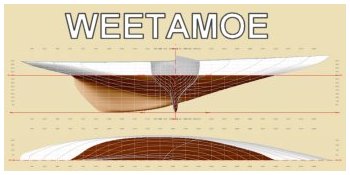 Weetamoe was designed by Clinton Crane as a possible defender of the America’s Cup in 1930 with Enterprise, Whirlwind and Yankee. She was the narrowest of the early four.
Weetamoe was designed by Clinton Crane as a possible defender of the America’s Cup in 1930 with Enterprise, Whirlwind and Yankee. She was the narrowest of the early four.
Despite claims that Yankee was the best all-rounder, Weetamoe is said to have been the closest rival to Enterprise to be the Cup defender.
Charles Nedwick, in Ian Dear’s book Enterprise to Endeavour, describes Weetamoe as having a profile “that is practically a triangle, with a straight line from the after end of the waterline to the bottom of the keel and thence a line which is slightly convex, and then slightly concave to the forward end of the waterline.”
In an attempt to better performance and make her less tender, her profile below the water was radically altered in 1934 with a new contour and bulb keel. The alterations failed and not long afterwards were reversed. In common with the other J’s, she had about 43ft of overhang and her hull, Nicholson opined, “was the best of all the US Js”.
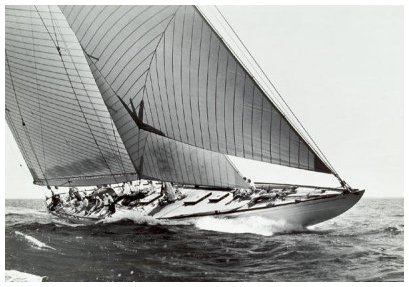 From "Sailing, Seamanship and Yacht Construction" By Uffa Fox : ...As these races ranged over three months, June, July and August, all weather conditions from strong winds to heavy calms were experienced, so Weetamoe may be looked upon an excellent example of a yacht to the “J” class rule, for even when the rule calling for heavier masts was made after the 1930 contest, because of her length and displacement Weetamoe was still able to win races, while the shorter Enterprise was not fitted to the altered rule, as it was thought that she would not be powerful enough to win races with a 5,500 lb. mast (1,500 lb. heavier than her 1930 mast) plus the 7 tons of internal accommodation the altered rule demanded, for all the extra weight would have to be taken from her lead keel.
From "Sailing, Seamanship and Yacht Construction" By Uffa Fox : ...As these races ranged over three months, June, July and August, all weather conditions from strong winds to heavy calms were experienced, so Weetamoe may be looked upon an excellent example of a yacht to the “J” class rule, for even when the rule calling for heavier masts was made after the 1930 contest, because of her length and displacement Weetamoe was still able to win races, while the shorter Enterprise was not fitted to the altered rule, as it was thought that she would not be powerful enough to win races with a 5,500 lb. mast (1,500 lb. heavier than her 1930 mast) plus the 7 tons of internal accommodation the altered rule demanded, for all the extra weight would have to be taken from her lead keel.
One is struck by the ease of each of Weetamoe’s lines, and how very like its neighbour each one is, for there is no sudden change in the diagonals, buttocks or water-lines. But in the sections a change can be seen, which at first sight is startling, for the bow sections above and on the water-line are sharp, and then one notices the first four sections abaft the fore end of the water-line are rounded in rather quickly at the bottom after which they become sharp again. This rounding is not to cheat any rule but an effort to cut down wetted surface, and a glance at the fore endings of the water-lines will show that those above the water-line are sharp and gradually get fuller and fuller till down at the lead keel they resemble the bow of a torpedo.
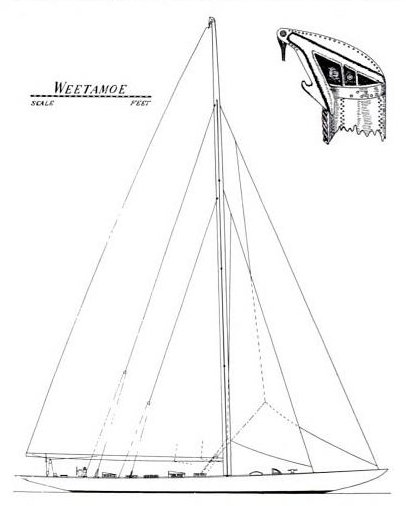 That Weetamoe’s designer studies every detail very carefully I know full well, for he taught another youngster and myself archery. The two of us shot against him, but his patience and ability to note the tiny details generally unseen soon saw our combined scores so great that he could not equal them though generally all his arrows but one would be in the gold, and that one only just out. And so looking at Weetamoe’s lines I can picture him quietly and carefully perfecting the unusual underwater bow of Weetamoe.
That Weetamoe’s designer studies every detail very carefully I know full well, for he taught another youngster and myself archery. The two of us shot against him, but his patience and ability to note the tiny details generally unseen soon saw our combined scores so great that he could not equal them though generally all his arrows but one would be in the gold, and that one only just out. And so looking at Weetamoe’s lines I can picture him quietly and carefully perfecting the unusual underwater bow of Weetamoe.
In 1930, Weetamoe had a three headsail rig very similar to Britannia’s, as did all the large cutters, but the rule forcing a heavier mast and the knowledge gained in the next three years enabled her to be rigged with two headsails for the 1934 season. This is a more efficient rig, for there is no doubt that the middle headsail of the three disturbs the after one (staysail) and with the knowledge increasing years will bring there is little doubt that these large cutters will all have single headsail in spite of the difficulty in staying a mast to support them and the harder work in handling such a sail.
The two backstays are as they should be, entirely separate, and while the one taking the strain of the fore stay is the same distance abaft the mast as the foot of the fore stay is forward of it, the one taking the jib strain is not as far aft as its corresponding stay is forward. The reason for this, it would seem, is to keep this stay forward of the helmsman, for the sound of a wire backstay twanging in a breeze behind a helmsman might easily disturb his peace of mind, and so take his attention off the race.
Two things are noticeable in this mast. Due to its size it needs no topmast stay or topmast backstay, a saving in windage of 300 ft. of wire, but, more than this, the absence of the topmast forestay puts all the pull of the main sheet directly upon the fore and jib stays, which means that they must be taut on a wind. We successfully rigged the 6-metre Nada this way some time back. The thing against such a strong mast is its size and windage, for Weetamoe’s mast is 2 ft. 6 in. athwart ships, and such a spar must disturb the luff of a mainsail directly behind it unless it revolves, which the rules will not permit.
 The other clever point of Weetamoe’s rig is the hook at the masthead to take the head of the mainsail; this relieves the mast of half the compression strain due to the main halyard. The mainsails of this large cutters weigh about three-quarters of a ton, so there must be that same strain on the halyard to hold it up, making a total strain of 1,5 tons, without taking into consideration the extra strains put on to stretch the luff taut and those set up when the mast shortens under compression and then straightens out in going about. That hook halves some of these loads and entirely frees the mast of the others. In England a wire strop is fitted to the masthead, and one of the crew go aloft to shackle the mainsail headbord to this, but Weetamoe’s masthead hook does away with this entirely. The masthead hook is solid and does not move, but looking at the sail plan it will be seen that the main halyard block on the headboard has an eye worked into its upper part; this is lashed towards the mast when the sail is hoisted (for it must be remembered that such a mainsail shakes and flogs about a great deal when being hoisted in a breeze).
The other clever point of Weetamoe’s rig is the hook at the masthead to take the head of the mainsail; this relieves the mast of half the compression strain due to the main halyard. The mainsails of this large cutters weigh about three-quarters of a ton, so there must be that same strain on the halyard to hold it up, making a total strain of 1,5 tons, without taking into consideration the extra strains put on to stretch the luff taut and those set up when the mast shortens under compression and then straightens out in going about. That hook halves some of these loads and entirely frees the mast of the others. In England a wire strop is fitted to the masthead, and one of the crew go aloft to shackle the mainsail headbord to this, but Weetamoe’s masthead hook does away with this entirely. The masthead hook is solid and does not move, but looking at the sail plan it will be seen that the main halyard block on the headboard has an eye worked into its upper part; this is lashed towards the mast when the sail is hoisted (for it must be remembered that such a mainsail shakes and flogs about a great deal when being hoisted in a breeze).
The sketch on the sail plan illustrates the masthead. It shows the hook which takes the main halyard block, and the angle above, which breaks the lashing holding the eye of the block towards the mast, so enabling the spring that takes it away to come into action when the sails to be lowered. It will be seen that the main halyard is made fast to the top of the mast, leads through the block on the headbord and then back over a sheave inside the masthead, and down inside the mast.
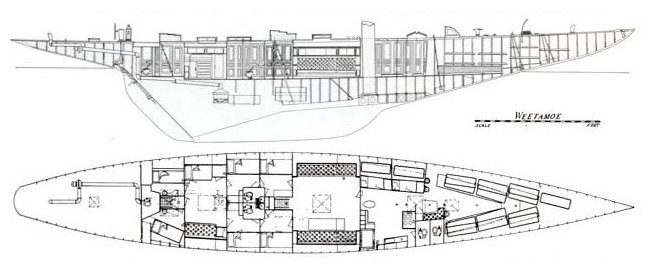 Altogether Weetamoe’s sail plan and her masting and rigging are a great advance and worthy of study.
Altogether Weetamoe’s sail plan and her masting and rigging are a great advance and worthy of study.
In Weetamoe fo’c’sle there are fifteen cots, two of which are over the settee just forward of the coal stove. Then there are two double-berthed cabins, which take the cook, steward and the two mates, bringing the crew accommodation up to nineteen. The cook has a roomy gallery, 12 ft. by 10 ft., just forward of the mast. In this space is the stove, the crew’s sink and pantry, and the owner sink and pantry. At first sight this does not appear to be a great deal of space; but the aboard such a vessel as Weetamoe is seldom more than thirty all told, and when we remember that on a train the cook has to turn out a dinner of six or seven courses for as many as a hundred people, whose appetites have not been whetted by the keen salt air, gourmands who complain of food, not because the food is bad but because they and their insides are soured, in a gallery the width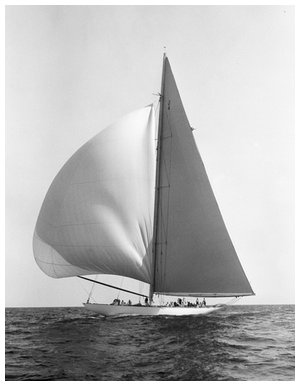 of a carriage, minus the alley-way, bringing his gallery down to 12 ft. by 6 ft., which with the train rushing along at 70 or more miles an hour sways and rocks about violently for a train’s motion, although not so much as a vessel’s at sea, is quicker and move spiteful, we begin to think that a gallery like Weetamoe’s is quite a roomy place.
of a carriage, minus the alley-way, bringing his gallery down to 12 ft. by 6 ft., which with the train rushing along at 70 or more miles an hour sways and rocks about violently for a train’s motion, although not so much as a vessel’s at sea, is quicker and move spiteful, we begin to think that a gallery like Weetamoe’s is quite a roomy place.
Weetamoe’s ship’s company of nineteen men live comfortably and happily in a fo’c’sle 45 ft. long with an average width of 12 ft., from the mast to the bows.
Directly abaft the mast is the main saloon which is 13 ft. 6 in. long by 18 ft. wide with a considerable lounge each side, two tables, and a companionway which leads straight out on to the deck. Abaft this are four staterooms for guests, and in finest lace of the ship is the owner’s cabin the full width of Weetamoe, 8 ft, fore and aft and 18 ft. athwartships, with a 3 ft. wide sleeping berth to port and a lounge to starboard, leaving a great deal of floor space in spite of the table at the fore end of the cabin. Aft of this is a companionway in the center, which divides the captain’s cabin to starboard from a single stateroom on the port side. In the rest of the ship from these cabins aft the sails are stored in a space 20 ft. long with an average width of 12 ft. and an average depth of 4 ft.
In spite of the ample headroom throughout Weetamoe there is still a great deal of room under her floor, which in places amounts again to full headroom, and this causes one to wonder if the displacement of these large racers could be less, and give owners faster vessels.
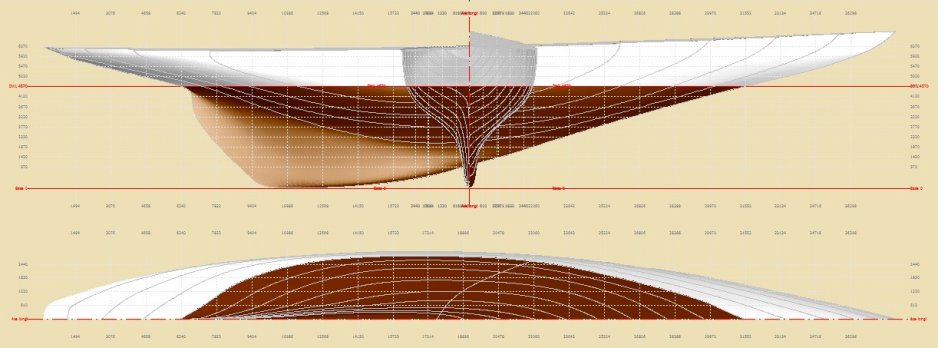

Download DELFTSHIP LINES : Delftship file to finish and background images

